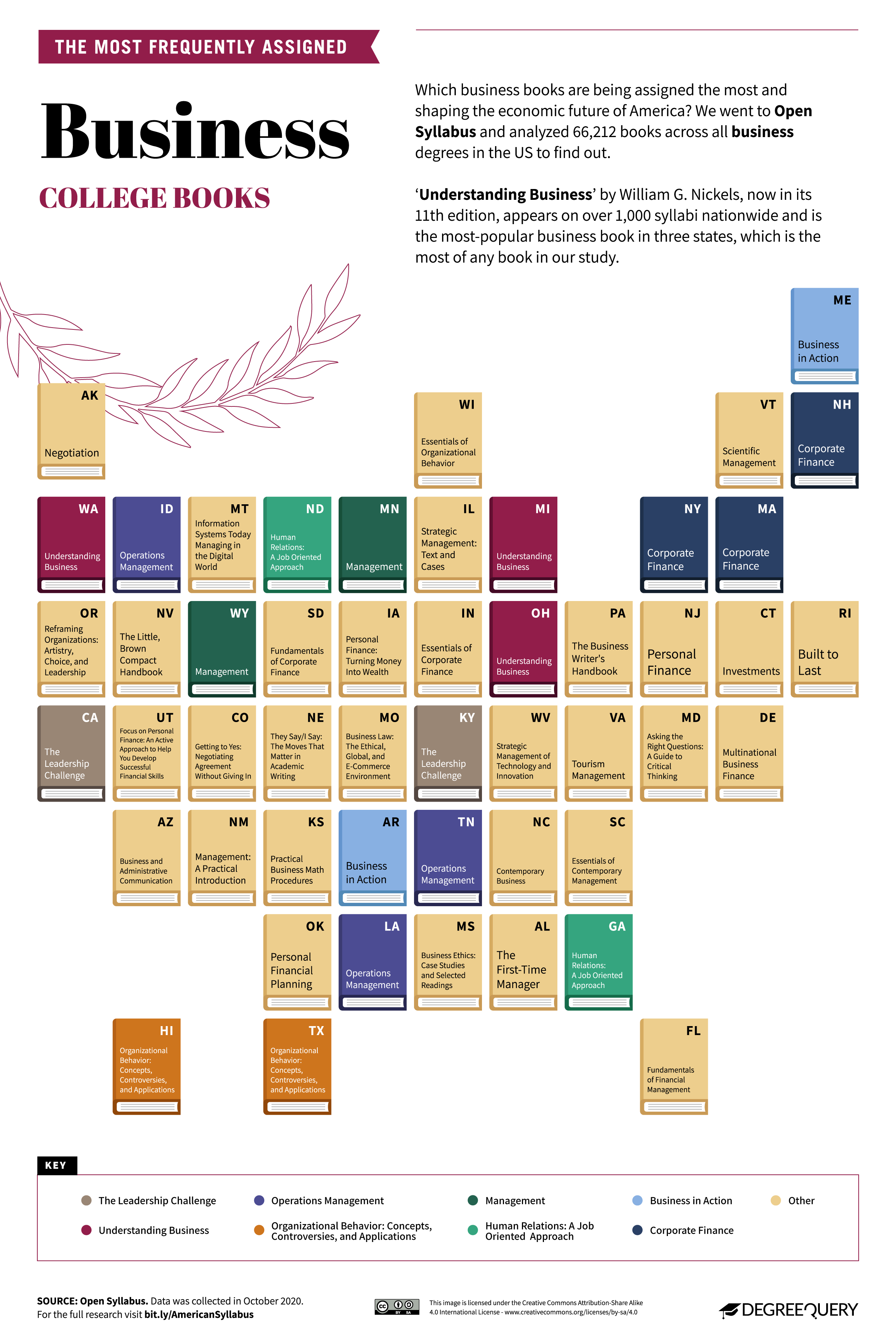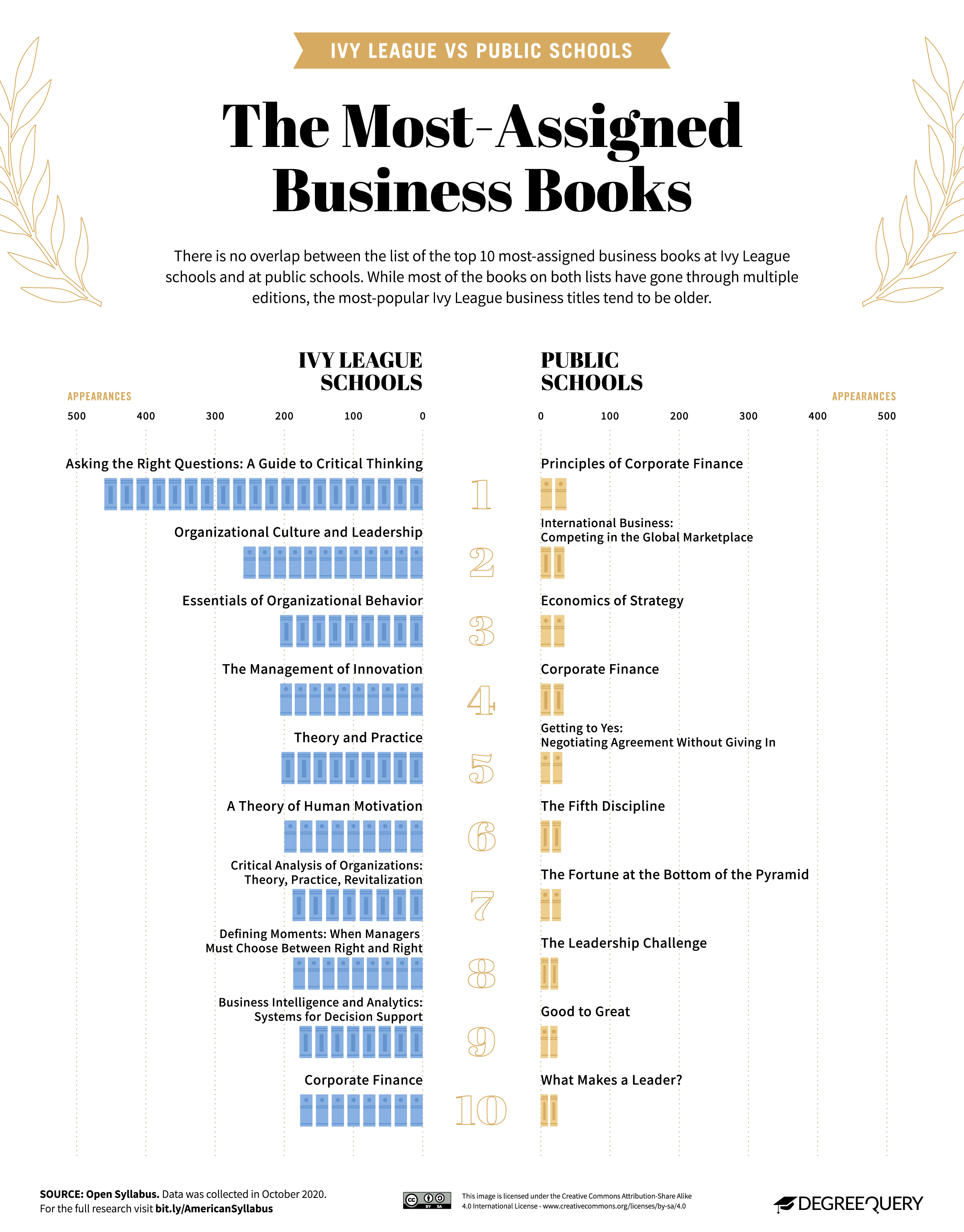Success Advice
The Best Business Books That Are Shaping the Future

Today’s business students are tomorrow’s business leaders, entrepreneurs, and policymakers. So DegreeQuery thought it would be a good idea to find out what books are shaping the minds that will shape our future. Using data from Open Syllabus, DegreeQuery researchers identified the most assigned business books at public schools and Ivy League colleges.
And although no books appear on both lists, they still found some big overlaps in the subject matter. For example, Ivy League and Public Schools both put a strong emphasis on leadership skills. The Essentials of Organizational Behavior by Stephen Robbins and Organizational Culture and Leadership by Peter Schein made it onto the Ivy League’s most popular reading list.
At the same time, public school students are learning the art of effective management from Daniel Goleman’s insightful collection of essays, What Makes a Good Leader: Why Emotional Intelligence Matters. Goleman’s often cited work combines business strategy with the latest neuroscientific research to create a data-led approach to boosting performance, fostering effective relationships, and encouraging innovation.
“Sow a thought, reap an action; sow an action, reap a habit; sow a habit, reap a character; sow a character, reap a destiny.” – Stephen Covey
And both public and private Ivy League schools are making sure that future business leaders understand a company’s greatest resource – its people. Abraham Maslow’s A Theory of Human Motivation is one of the most assigned pieces of reading at the Ivy League. First published in 1943, A Theory of Human Motivation is a classic paper on what Maslow called the hierarchy of needs – a vital theory in developmental psychology for understanding human motivation.
Peter Senge, a senior lecturer at the Massachusetts Institute of Technology (MIT), explores Maslow’s ideas in The Fifth Discipline. A fixture on public school reading lists across the states, Senge’s book argues that enabling employees to achieve personal mastery is one of the quickest ways to make any business a success.
You can see what other business books are shaping the future by checking out the infographic below:
Did You Know
How Skilled Migrants Are Building Successful Careers After Moving Countries
Behind every successful skilled migrant career is a mix of resilience, strategy, and navigating systems built for locals.

Moving to a new country for work is exciting, but it can also be unnerving. Skilled migrants leave behind familiar systems, networks, and support to pursue better job opportunities and a better future for their families. (more…)
Life
10 Research-Backed Steps to Create Real Change This New Year
This New Year could finally be the one where you break old patterns and create real, lasting change.

Every New Year, we make plans and set goals, but often repeat old patterns. (more…)
Change Your Mindset
The Silent Skill That Makes People Respect You Instantly
What truly earns respect and why most people go about it the wrong way

Everybody craves respect but not everyone earns it. Some people believe that a title, years of experience, or a position of authority automatically entitles them to respect. (more…)
Entrepreneurs
The Essential Skills Every Entrepreneur Needs In 2026
Success in the digital age isn’t about luck. It’s about mastering the skills that separate dreamers from doers.

When I was 22 years old, I started my first side hustle as a ghostwriter. (more…)
-

 Entrepreneurs4 weeks ago
Entrepreneurs4 weeks agoThe Essential Skills Every Entrepreneur Needs In 2026
-

 Change Your Mindset3 weeks ago
Change Your Mindset3 weeks agoHow to Turn Your Mind Into Your Greatest Asset (Instead of Your Enemy)
-

 Change Your Mindset3 weeks ago
Change Your Mindset3 weeks agoThe Silent Skill That Makes People Respect You Instantly
-

 Life2 weeks ago
Life2 weeks ago10 Research-Backed Steps to Create Real Change This New Year
-

 Tech2 weeks ago
Tech2 weeks agoWhat’s in a Name? How to Get Your Domain Right
-

 Did You Know2 weeks ago
Did You Know2 weeks agoHow Skilled Migrants Are Building Successful Careers After Moving Countries




















